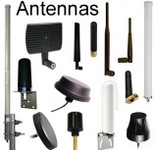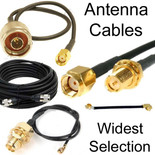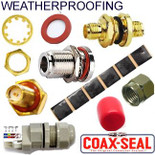Antennas, Antenna Cables, Wireless Products: Technical Articles
IoT Wireless Protocol Selection and Frequency Band Characteristics
The Frequency Bands of IoT Wireless
IoT (Internet of Things) is a growing network of objects, devices and machines each able to communicate with the other using a wireless network to access the Internet. IoT devices have a flexible range of both wired and wireless connectivity options. IoT protocols mostly use ISM band frequencies of 4.33GHz, 915MHz, 2.4GHz to 5GHz.
Characteristics of Different Frequency Bands
- Lower Frequencies (e.g., 433 MHz, 868 MHz): Longer range, better penetration, lower data rate.
- Higher Frequencies (e.g., 2.4 GHz, 5 GHz): Shorter range, higher data rates, less penetration.
- mmWave Frequencies (used in 5G): Very high data rates, extremely limited range and penetration.
Common IoT Wireless Technologies and Their Frequency Bands
- Wi-Fi: Primarily uses the 2.4 GHz and 5 GHz bands.
- Bluetooth: Operates in the 2.4 GHz ISM band.
- Zigbee: Also uses the 2.4 GHz ISM band.
- LoRa: Works in various bands including 433 MHz, 868 MHz (Europe), and 915 MHz (North America).
- NB-IoT: Operates in the LTE frequency bands.
- 5G IoT: Utilizes a range from sub-1 GHz to mmWave frequencies.
Short-range IoT wireless devices
- Mostly use Bluetooth and ZigBee. Short-range connectivity is most common in IoT applications.
- Bluetooth antennas operate at the 2.400 to 2.485 GHz frequencies. Uses Ultra High Frequency Radio to exchange data between IoT devices over short distances.
- The range of Bluetooth can be greatly enhanced by antennas.
- Our ZigBee antennas are the same antennas that we designate as "Bluetooth Antennas", because ZigBee uses the same frequency range: 2.400 to 2.484GHz. ZigBee also uses 915 MHz band in the United States. ZigBee bears some similarities to Bluetooth but is simpler and cheaper to operate. A ZigBee antenna can be obtained as a Printed Circuit Board (PCB) antenna or omni directional external antenna with. ZigBee is a wireless personal area network (WPAN) which is characterized by being low-power, low-data rate and operating at close proximity. It does not require line of sight. Transmission distances are typically within 10 to 100m. ZigBee is named after the distinctive movements of honeybees.
- Wired IoT devices use Ethernet, coaxial or power communication cables.
Medium-range IoT wireless:
- For medium range, the LTE Advanced network is almost exclusively preferred for its low latency, high data rates, and extended range. Mid-range variants of WiFi such as HaLow are also used.
- 2G, 3G / GSM, 4G / LTE and 5G wireless, WiFi.
Long-range IoT wireless: LPWAN (Low-power wide-area networking) transmits at low data rates: LPWAN is ideal for long distance IoT transmissions for its economic power consumption and cost of transmission. Long-range satellites such as VSAT transmitting narrowband and broadband are also used.

All the LPWAN protocols, beginning with the three most popular:
- LoRaWAN stands for Long Range, and is a Low Power Wide Area Network (LPWAN) that enables long range transmissions of more than 10km with low energy consumption. LoRa operates at frequencies just under 1 GHz. Directional antennas are most suitable for LoRa antennas, although omni-directional antennas are often used. LoRaWAN was developed in France and derived from CSS as its first commercial implementation. LoRa exploits the sub-GHz RF bands such as 433MHz, 868MHz and 915MHz to facilitate long range transmission of over 10km with low power consumption, ideal for IoT connectivity.
- LTE-M. Long Term Evolution for Machines permits both voice and data transfer with mobility, low bandwidth and energy consumption.
- NB-IoT: Narrow Band-Internet of Things(NB-IoT) is a LPWAN developed by 3GPP which provides data transfer at low cost and low energy consumption at a frequency of 200kHz.
- DASH7: A sensor and actuator network protocol developed by the DASH7 Alliance (D7A). It is open source and wireless. DASH7 is able to utilize a range of LPWAN technologies for operation within the license free sub GHz frequencies, relying mainly on 433MHz.
- Sigfox: The Sigfox protocol was developed in 2009 in Toulouse, France and operates similarly to NB-IOT, as a narrowband LPWAN. It uses unlicensed ISM (industrial, scientific and medical) bands to operate.
- Wize: Wize is an open standard developed and released by the Wize Alliance in 2017. It harnesses the refurbished 169MHz frequency, previously used for pagers but now repurposed for smart utility metering and IoT applications.
- Chirp Spread Spectrum (CSS): This form of digital communication utilizes frequency modulation pulses known as chirps to encode information for transmission. The chirps are frequency modulation pulses. The transmitted signal is spread to occupy the available frequency spectrum.
- Weightless: This form of communication uses open source wireless technology that allows exchange of data between base stations and multiple machines or devices in its vicinity. The connectivity standard Weightless-P has had traction as a bi-directional narrowband network that can operate at both licensed and unlicensed frequencies.
- Telegram Splitting: This license free and standardized LPWAN technology splits a transmitted data packet into numerous smaller portions of data and transmits these sub-packets at different times and sub-GHz frequencies. As less information is transmitted at a time, data transfer is fast, scalable and secure against interference, with ultra-low bandwidth consumption. MIOTY protocol harnesses this technology for large-scale industrial and commercial IoT deployments.
- NB-Fi Protocol: This protocol is license free, operating in the ISM band. Developed by WAVoT, it is an ultra narrow band (UNB) technology and can achieve transmission distances of up to 30km in rural areas and even underground and low battery consumption lasting up to 10 years.
- Random Phase Multiple Access (RPMA): This wireless technology, previously known as On-Ramp Wireless was developed by Ingenu for IoT and M2M applications. It operates using the 2.4GHz band with a stand-alone broadcast channel and can be deployed globally.
- Ultra Narrow Band (UNB): These LPWANs, delivered are characterized by their extremely narrow and selective bandwidths. Short infrequent transmissions can be delivered over VHF or UHF frequencies for long distance and low energy consumption communication by IoT and other devices.
- Taggle Byron: This Australian-based venture has developed this radio technology to provide a low cost, low power and long range communications solution.
- WAVIoT: This LPWAN has been developed specifically with IoT and M2M bi-directional communication in mind. WAVIoT harnesses ISM bands using the NB-Fi protocol for applications such as utility metering.
Factors Affecting Protocol Selection for IoT Applications
When selecting wireless technology for Internet of Things (IoT) applications, the following key factors need to be considered to ensure optimal performance and efficiency:
- Range: The distance over which the IoT device needs to communicate is crucial. Short-range technologies like Bluetooth and Wi-Fi are suitable for home or office environments, while long-range technologies like LoRaWAN or NB-IoT are better for industrial or agricultural applications where devices are spread out over large areas.
- Data Rate: Different applications require different data throughput. High-data-rate technologies like Wi-Fi are suitable for applications like video streaming, while low-data-rate technologies like Zigbee or LoRa are sufficient for sensors transmitting small amounts of data.
- Power Consumption: IoT devices often run on batteries, so power efficiency is a significant consideration. Technologies like Bluetooth Low Energy (BLE) or Zigbee are designed for low power consumption, making them ideal for devices that need to operate for extended periods without recharging.
- Network Topology: The structure of the network - whether it's point-to-point, star, mesh, or something else - affects the choice of technology. Mesh networks are robust and self-healing, ideal for smart home applications, and can be implemented with technologies like Zigbee.
- Security: Security needs vary depending on the application. Technologies like Wi-Fi offer advanced security protocols, which are crucial for applications handling sensitive data.
- Cost: The cost of implementing and maintaining the technology is always a consideration. Some technologies require more expensive hardware or have higher operational costs due to power consumption or network fees.
- Interference and Reliability: In environments with many wireless devices or heavy machinery, interference can be a significant issue. Selecting a technology that operates on a less crowded frequency band or one that has robust interference mitigation techniques can be critical.
- Scalability: The ability to scale the network as the number of connected devices grows is essential. Some technologies are better suited to small networks, while others can handle thousands or even millions of devices.
- Regulatory Compliance: Wireless technologies must comply with regional regulations concerning spectrum use. It's important to choose a technology that is legal and optimized for use in the intended geographical area.
- Latency: The time it takes for data to travel from the source to the destination can be critical in applications like industrial automation where real-time data processing is required.
- Environmental Factors: The operating environment (indoor/outdoor, urban/rural, temperature extremes, etc.) can greatly affect the performance of wireless technologies.
- User Requirements and Experience: Consideration of the end-user experience and specific requirements of the application, such as ease of setup and use, can also guide the choice of technology.

About IoT: Devices, antennas, History and Future
- The devices (“Things”) are common everyday devices and equipment, including smartphones, wearables, vehicles, and instruments.
- Each device in the network is uniquely identifiable and able to exchange data with other devices over IP. Devices are embedded with software and connectivity features to enable this communication.
IoT wireless protocols are rapidly developing and as the means for a wide variety of applications which make machines, devices and communications more effective, increase their functionality and enable them to 'speak’ to each other.
The term Internet of Things (IoT) was coined by a MIT academic in 1999, and initially referred to Radio Frequency ID (RFID) technology for devices.
Wireless IoT systems use antennas to transmit or receive information and usually operate in association with wireless routers to improve the signal to and from the device they are connected to. They connect to a processor which can then, depending on how it has been programmed, perform an action with any need for user input.







